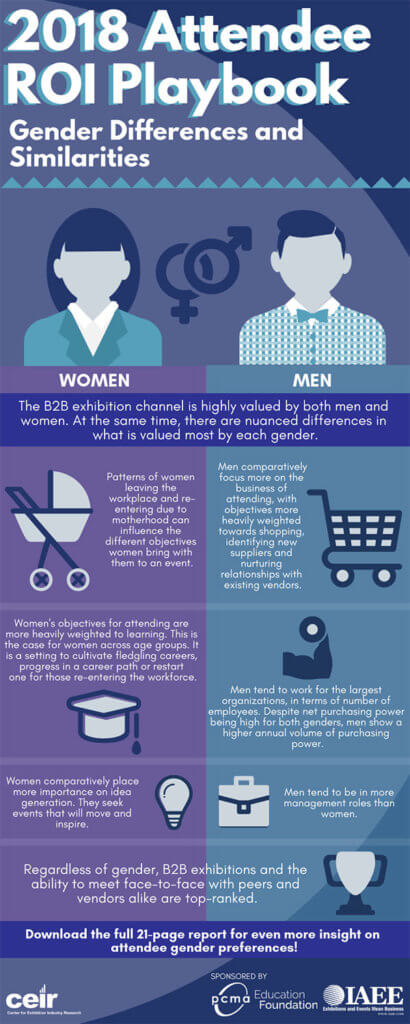As event marketers work to attract traffic to their trade-show floors, it’s common to tailor messaging based on where those prospective attendees live, what type of companies they represent, their age, and a number of other demographic factors. But what about a more fundamental piece of their identity — i.e., their gender?
The Center for Exhibition Industry Research (CEIR) sought to determine, by analyzing attendee data from 21 exhibition organizers, whether there are differences in what men and women look to experience on the trade-show floor. The results of the research, “Gender Differences and Similarities,” supported by the PCMA Foundation and the International Association of Exhibitions and Events (IAEE), reveal some similarities and striking differences.
 Buying & Boosting Brainpower
Buying & Boosting Brainpower
Not surprisingly, men and women share some of the same objectives in attending trade shows such as shopping, checking out new products, and seeing new technology — the core value proposition of nearly every exhibit hall. However, they go in different directions when it comes to the additional benefits of the face-to-face experience. Men arrive ready to tackle standard business goals; more of them said their aim is to prospect for suppliers and build relationships with exhibitors. Women, on the other hand, are more focused on expanding their knowledge. Seventy-three percent of female respondents ranked going to seminars and listening to speakers among their top reasons for attending, versus 54 percent of men.
“There are a number of nuanced differences for organizers and exhibitors to pay attention to, and one ‘aha’ for me is the importance of learning for women,” CEIR CEO Cathy Breden, CMP, CAE, said when the findings were released. “We know B-2-B exhibitions are a valued resource for both men and women to get the training they need for career success. Though this research speaks to unique needs for women, that learning is important at a higher rate regardless of their age.”
Millennials to Motherhood
Age, though, is an important factor in understanding the makeup of trade-show audiences. The findings revealed significant differences between genders based on age groups. Females make up nearly 60 percent of the Millennials who attend trade shows. As the audience gets older, the show floor skews toward males. Among Generation X attendees, 55 percent are male, and 64 percent of Baby Boomer attendees are male. The report references data from the U.S. Bureau of Labor Statistics to help explain these gaps, such as the fact that some women exit the workforce when raising young children and return as their children go to school and grow up.
“Career stages are apt to vary for women over the course of their lives,” Breden said. “For younger women, learning is important to help advance their fledgling careers. For some women re-entering the workforce after their children reach a certain age, it is a setting to jumpstart careers.”
According to responses from nearly 2,000 women in a 2017 Ovia Health survey, 34 percent of women do not return to their jobs after having a baby. Even for the 66 percent of women who do remain in their jobs, it’s easy to see how the traditional trade-show environment would present a challenge: Many do not offer childcare options. Rebecca M. Calisi “and a working group of mothers” posted an editorial about this issue on the PNAS (Proceedings of the National Academy of Sciences of the United States of America) website: “Primary caretakers of dependent children face inequitable hurdles to fully attending and participating in conference activities because of responsibilities related to pregnancy, breastfeeding, and caretaking. It’s a serious problem because it creates a culture of inequity for parents, with mothers generally experiencing greater disadvantages than fathers because of biological, prejudicial, and often socially driven childcare demands. With solutions seemingly elusive, many women, and occasionally men, make a calculated decision to forego conference attendance and suffer the career consequences.”
There are some exceptions, though. Attendees at the Natural Products Expo West, held at the Anaheim Convention Center in early March, were able to sign up for childcare services for $25 per day. At San Diego Comic-Con in 2018, attendees paid $10 per hour for childcare services for kids from six months to two years old and $8 per hour for kids from three to 12 years old.
Regardless of their career stage or whether they have children at home, one thing that resonates with female attendees, according to the CEIR research, is inspiration. Twenty-eight percent more female attendees — 83 percent vs. 60 percent of their male colleagues — indicated that getting inspired and having the chance to recharge was a major motivator in registering to attend a trade show. So the show floor needs to be more than a collection of products. It should be a place where attendees can renew their enthusiasm for their work and their industry.
Interested in more insights? Click “Gender Differences and Similarities” to download the report for free.
